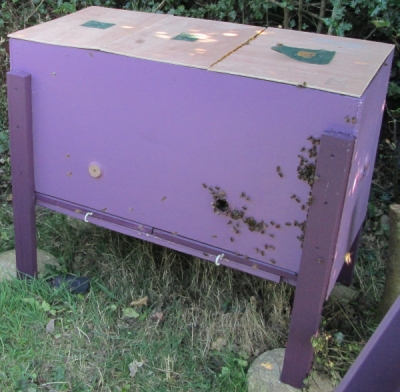
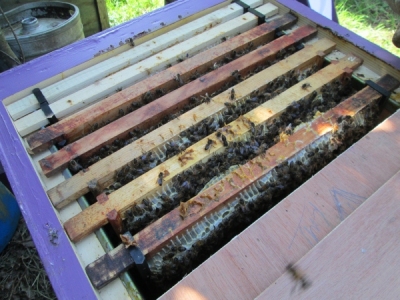
Lynn Roberts' Modified Lazutin Hive
The hive, situated on Anglesey (Ynys Môn) North Wales, is double walled with two circular entrances on one long side, one of which is in use in the photo below. The inner cover comprises three sheets of plywood which create a bee space above the top-bars. The inner cover has resting on it a soft quilt or pillow filled with wood shavings on which rests the roof. Comb depth is that of two National brood frames (395mm). Frame spacing is either with Hoffman frames or plastic Hoffman spacers.
The hive body has a frame of 2 x 1" (nominal) softwood. The inner hive wall is lined with new half inch thick untreated ply. All the rest of the wood is reclaimed. The outer wall of the hive body is quarter inch thick ply. 8 x 1" (nominal) softwood lengths are nailed to the bottom to keep in the warmth. The insulating filling inside the frame of the walls comprises three 5 mm sheets of fibreboard superimposed.
There is a mesh floor with a space 3" deep under it. I contains two detritus inspection boards (see white handles in photo below left). These are kept closed. The intention is, following Lazutin, to line the two boards with moss over winter to absorb any condensation in the hive. For ease of access, the inspection boards are openable from the front due to the location of the hive. The inner covers each have a mesh covered hole for ventilation. The one over the brood nest (rightmost in the photo below left) is almost entirely closed with propolis. It therefore seems unlikely that the hive is short of ventilation. The rebate in the walls for the frame lugs are fitted with steel runners for ease of frame removal in the event of propolisation of the lugs (see photo below right).


Some of the deep frames are made by adding national side-bars to the bottoms of National frames and supporting the joint with plastic Hoffman frame spacers (see photo below left). Other frames have combs uninterrupted by cross bars and comb support provided by diagonal lengths of nylon monofilament fishing-line (photo below right).
The roof comprises reclaimed 8 x1" (nominal) softwood sides with quarter inch ply nailed to it. It is weatherproofed temporarily with Correx twin-wall fluted polypropylene protection board, but will will be covered with aluminium sheet for winter.
Populating the hive
On 29 June 2018 a swarm was taken in a National 6-frame nucleus box, with undrawn foundation in all frames. That evening the swarm was tansferred from the nuc box to the hive along with two large frames each containing a one inch deep starter strip of foundation. The intention here was to start the swarm on straight combs and to add the National side bars and bottom bars to the six frames with the Hoffman converter clips. This was done on 2 July 2018. On 15 July 2018 a further three deep frames were added.
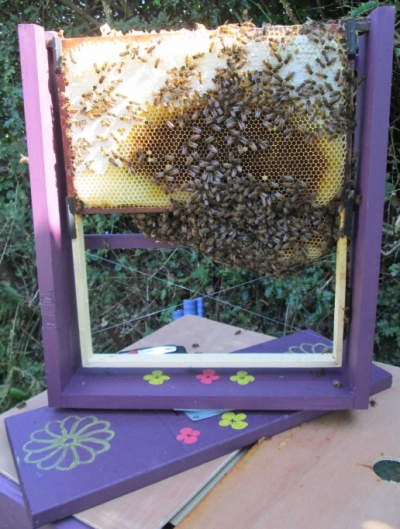
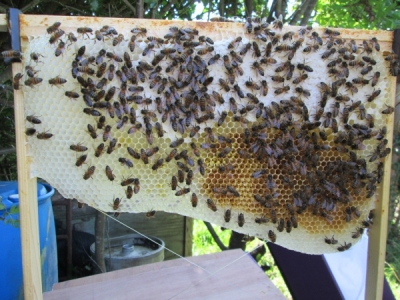
A rotatable holder facilitates comb inspection. On 31 July 2018 we found well populated combs with capped worker brood on several of them but no eggs. Plenty of pollen was coming in and many bees were clearly visiting Himalayan balsam (Impatiens glandulifera). The colony was very calm.
The outermost comb had an area with no middle wall. This is possibly due to bees 'borrowing' wax for use elsewhere.
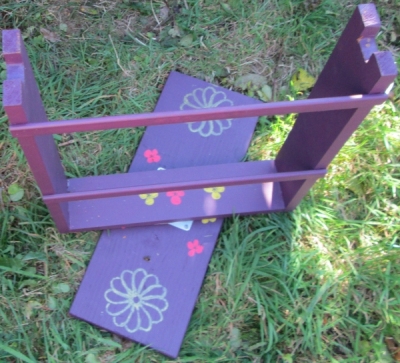
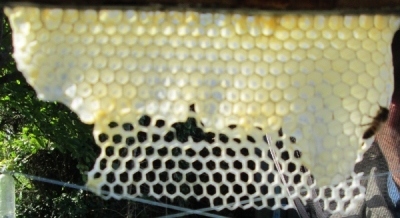
For more information on this hive contact Lynn Roberts: lynn-roberts1 (at) live.co.uk .
For more background on the Lazutin hive concept see David Heaf's modified Lazutin hive